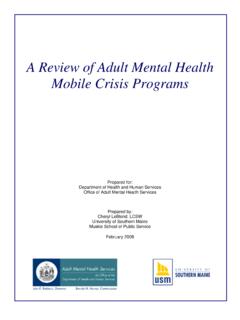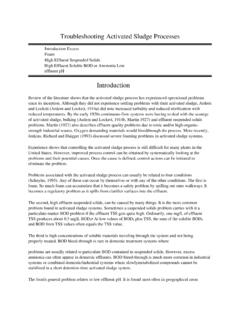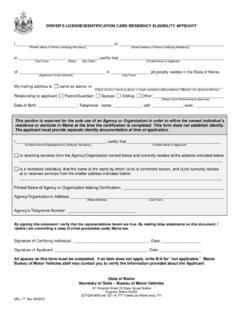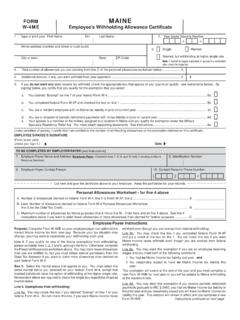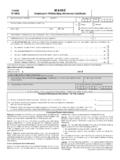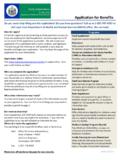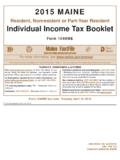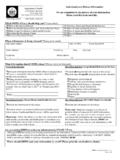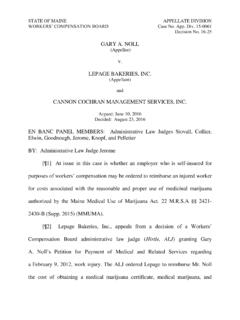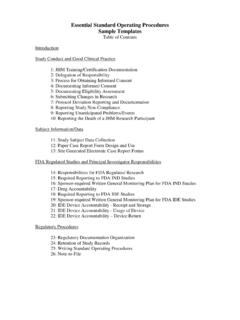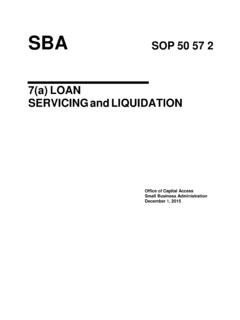Transcription of Standard Operating Procedure (SOP) - maine.gov
1 1 Standard Operating Procedure (SOP) First Issued: 8/26/2020 Revised: 1/11/2022 (See Change Log/Appendix F) SUBJECT: Investigation of COVID-19 Cases in Pre-K-12 Schools maine Center for Disease Control and Prevention Division of Disease Surveillance I. PURPOSE This SOP provides a framework for responding to COVID-19 cases among students, teachers, or staff within a school. The guidance in this SOP is not exhaustive, nor does it replace a school s strategic plan for COVID-19, or direct engagement with the maine Department of Education ( maine DOE) or maine Center for Disease Control and Prevention ( maine CDC). The primary goal of this document is to enable students and staff to remain in the school classroom through vaccination, pooled testing, isolation/quarantine, and masking.
2 II. ISOLATION AND QUARANTINE Case Definitions maine CDC is following case definitions for COVID-19 as established by the Council of State and Territorial Epidemiologists. The current case definitions can be found here. These case definitions are subject to change. School Responsibilities A designated school staff member affiliated with the school where a case of COVID-19 is identified will be the primary point of contact and serve as an essential part of any epidemiological investigation. The designee should contact other applicable designated school administrators, school health advisors/school physicians, as needed. The designated school staff member shall serve as the primary point of contact for families of confirmed cases.
3 The designee should: Communicate with the family of a COVID-19 case and share guidance on isolation and quarantine for the COVID-19 case and for family members living in the same household; Provide an anticipated release from isolation date; Make social service referrals with the family s permission to Recommend that the parent/guardian monitor other family members for symptoms of COVID-19; Advise families to alert their health care provider of the positive COVID-19 test, especially if symptoms worsen; and Advise close contacts to seek a COVID-19 test 5 days following exposure. Laboratory Testing maine CDC recommends testing close contacts of COVID-19 cases. Asymptomatic close 2 contacts should test on day 5 following exposure.
4 Symptomatic close contacts should test as soon as possible. Individuals identified as close contacts should follow the CDC s guidance on quarantine. Testing of close contacts also helps identify additional cases and helps identify further close contacts who should quarantine. PCR confirmation of a positive antigen test is not required if the antigen test is conducted on an individual with a known exposure to a positive case or linked positive PCR pooled test. Pooled testing participants do not need additional testing beyond the pooled and follow-up testing if identified as close contacts, provided they remain asymptomatic. In general, individuals who test positive should not be retested for 90 days following the date of the positive test result.
5 However, an individual who develops new onset of symptoms consistent with COVID-19 infection during the 90-day period following the initial positive test collection date should be retested and should isolate until 24 hours after symptoms have resolved although there will not be contact tracing. An individual who tests positive again 90 days after the last positive test must complete isolation following the new, positive result. At-Home Test Results With increasing availability of at-home COVID-19 tests, schools may choose to accept the results from such tests. Please note that maine CDC does not investigate or accept reports of positive results from at-home tests or count such positive results as cases.
6 maine CDC recommends that schools that choose to accept home-based test results do so when the school is able to verify the collection date and patient. Having this information will help determine the start and end dates of isolation and quarantine, if indicated. School-Based Pooled Testing maine CDC and maine Department of Education (DOE) have implemented a pooled PCR testing program, available to public and private schools (private pre-K-only programs are not eligible to apply). Pooled testing involves mixing several test samples together in a batch or pool and then testing the pooled sample with a PCR test for detection of SARS-CoV-2. Students who participate in this pooled testing program can avoid quarantine if exposed to COVID-19, regardless of vaccination status.
7 In December 2021, the CDC issued guidance on a Test to Stay strategy for students exposed to COVID-19. Test to Stay is a practice comprising contact tracing and serial testing to allow school-associated close contacts who are not fully vaccinated to continue in-person learning and avoid quarantine. maine s Test to Stay program is the pooled testing program. maine CDC recognizes that schools may opt for an alternative Test to Stay strategy via daily antigen testing as another approach to minimize quarantine. Isolation Isolation is the process of separating individuals who are infected with COVID-19 from others. All students, teachers, or staff who test positive for COVID-19 shall isolate until they meet the CDC criteria for release from isolation, regardless of vaccination status.
8 See Appendix G. If a student, teacher, or staff has access to a test and wants to test during isolation, the best 3 approach is to use an antigen test toward the end of the 5-day isolation period. Follow CDC guidance for details on testing. If the test result is positive, continue to isolate until day 10. If the test result is negative, isolation can end (on or after day 6), and the student, teacher or staff can return to school. When returning to school after isolation, wearing a well-fitting mask for an additional five days (until day 10) is required at all times when around others indoors, except when eating or drinking. The school should ensure there is a plan for people ending isolation and undergoing their 5 additional days after the end of isolation to stay masked at all times.
9 During times in the school day when students or staff members may typically remove masks indoors (such as during lunches, snacks, etc.), schools should have a plan for them to adequately distance from others and ensure they wear their masks when not actively participating in these activities (such as when they are not actively eating). Contact Tracing and Quarantine Contact tracing is the process of identifying and notifying individuals (or their families) who have had close contact with someone infected with COVID-19. Quarantine is the process of separating and restricting the movement of persons who were in close contact with someone who tested positive or had symptoms of COVID-19. See Appendix H.
10 maine CDC recommends that schools conduct contact tracing unless the school consistently observes and enforces a universal masking policy (see Section V) for all teachers, students, staff, and visitors. Schools that are not conducting contact tracing may continue to notify parents and families of in-school exposures, where such close contact identification is possible. Schools that do not observe and enforce a universal masking policy should continue to conduct contact tracing. After isolating a positive case, the school-designated contact tracer should identify and notify all close contacts (see Appendices). For schools that are conducting contact tracing: o maine DOE will work with school officials to provide technical assistance to identify close contacts within schools, if needed.
